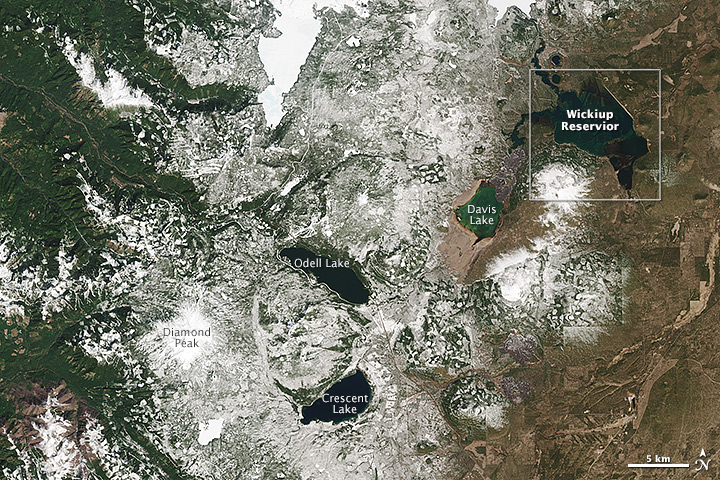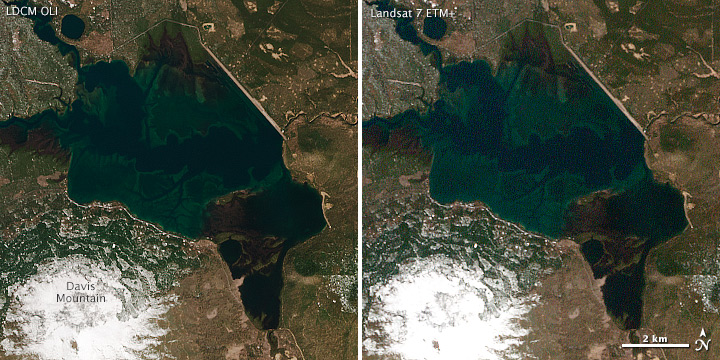NASA: A Dynamic Landscape. a Dynamic Sensor - 05.05.13
Posted by Ricardo Marcenaro | Posted in NASA: A Dynamic Landscape. a Dynamic Sensor - 05.05.13 | Posted on 16:29

acquired March 30, 2013
download large image (7 MB, JPEG, 4420x4420)
acquired March 30, 2013
download GeoTIFF file (49 MB, TIFF)

acquired March 30, 2013
The newest Landsat satellite—the Landsat Data Continuity Mission
(LDCM)—is especially adroit at providing meaningful information across a
broad range of landscapes. A patchwork of national forests in the
Cascade Mountains of the Pacific Northwest of North America provides a
great test for the eyesight of the new satellite because the area has
such a wide dynamic range of colors, topography, and brightness (or reflectance).
The Operational Land Imager (OLI) on LDCM acquired the top image
above on March 30, 2013. It shows portions of the Willamette and
Deschutes National Forests, in an area about 40 miles southwest of Bend,
Oregon, and 50 miles north of Crater Lake.
In this natural-color image, the deep, dark hues of Odell and Crescent
Lakes and Willamette’s Douglas-fir forests contrast with the bright
mountaintop snows and the arid dirt and rock to the east.
The lower, side-by-side image comparison shows a subsection of the
large OLI image (left) as well as data collected by the Enhanced
Thematic Mapper Plus (ETM+) on Landsat 7 on the same day. In order to
achieve greater sensitivity to brightness and color, the OLI instrument
on LDCM (as well as the Thermal Infrared Sensor)
was designed to produce 12-bit data. The previous generation of sensor,
ETM+, gathers 8-bit data. This means that instead of trying to describe
every pixel from the brightest to the darkest with 256 data values, OLI
uses 4,096 values to digitize its signal, which is less noisy over a
wider range.
The practical effect of this refinement is apparent when comparing
the OLI and ETM+ images of Davis Mountain (bright) and Wickiup Reservoir
(dark). In the OLI view (open the large image file),
OLI shows more nuanced details in the rocks and shadows on the
6,825-foot-tall Davis Mountain. Similarly, the shoreline and marshlands
of the shallow Wickiup Reservoir are more easily discerned.
During a four-day period from March 29 to April 1, 2013, LDCM flew on
the same orbital path but a few miles under Landsat 7. This under-flight
allowed the two satellites to collect data in tandem over the same
landscapes at the same time. With nearly identical atmospheric and solar
illumination conditions, LDCM researchers now have a strong data set
for comparisons and calibrations of imagery between the two satellites,
extending the 41-year record of land observations.
Further Reading
- Bureau of Land Management Wickiup Dam. Accessed April 29, 2013.
- NASA Earth Observatory (2013, April 16) Eye Exam for a Satellite.
- NASA Earth Observatory (2012, July 23) Landsat Looks and Sees.
- NASA Landsat Data Continuity Mission. Accessed April 22, 2013.
- NASA The Landsat Program. Accessed April 22, 2013.
Images by Robert Simmon and Jesse Allen, using Landsat data from the U.S. Geological Survey and NASA. Caption by Laura Rocchio.
- Instrument:
- Landsat 8 - OLI
NASA: A Dynamic Landscape. a Dynamic Sensor - 05.05.13
Ricardo M Marcenaro - Facebook
Blogs in operation of The Solitary Dog:
Solitary Dog Sculptor:
http://byricardomarcenaro.blogspot.com
Solitary Dog Sculptor I:
http://byricardomarcenaroi.blogspot.com
Para:
comunicarse conmigo,
enviar materiales para publicar,
propuestas comerciales:
marcenaroescultor@gmail.com
For:
contact me,
submit materials for publication,
commercial proposals:
marcenaroescultor@gmail.com
My blogs are an open house to all cultures, religions and countries. Be a follower if you like it, with this action you are building a new culture of tolerance, open mind and heart for peace, love and human respect.
Thanks :)
Mis blogs son una casa abierta a todas las culturas, religiones y países. Se un seguidor si quieres, con esta acción usted está construyendo una nueva cultura de la tolerancia, la mente y el corazón abiertos para la paz, el amor y el respeto humano.
Gracias :)


Comments (0)
Publicar un comentario